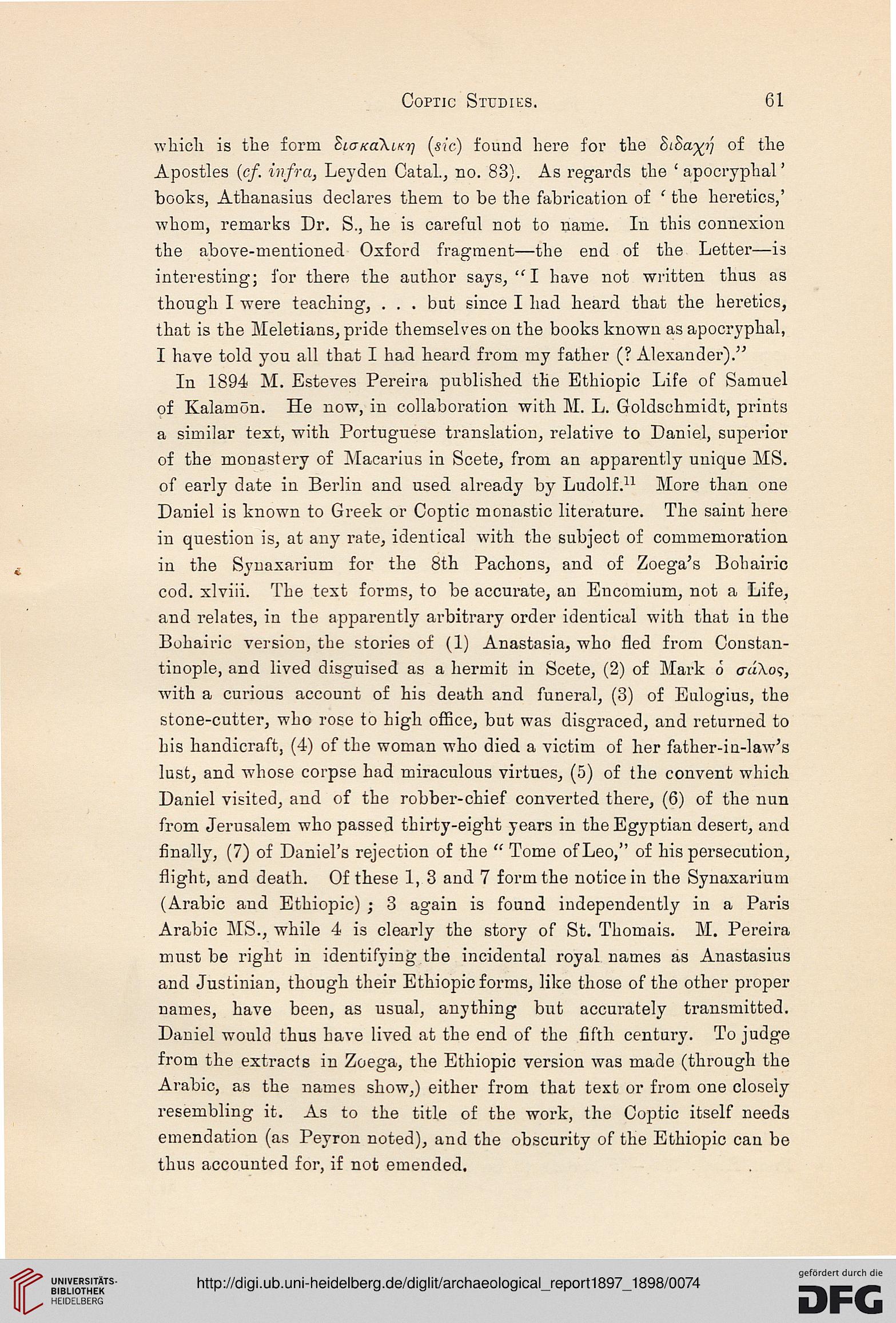Coptic Studies.
61
which is the form SicrKaXiKi) [sic) found here for the SiSa^ij of the
Apostles (cf. infra, Leyden Catal., no. 83). As regards the 'apocryphal'
books, Athanasius declares them to be the fabrication of ' the heretics,'
whom, remarks Dr. S., he is careful not to name. In this connexion
the above-mentioned Oxford fragment—the end of the Letter—is
interesting; for there the author says, <fI have not written thus as
though I were teaching, . . . but since I had heard that the heretics,
that is the Meletians, pride themselves on the books known as apocryphal,
I have told you all that I had heard from my father (? Alexander)."
In 1894 M. Esteves Pereira published the Bthiopic Life of Samuel
of Kalamon. He now, in collaboration with M. L. Goldschmidt, prints
a similar text, with Portuguese translation, relative to Daniel, superior
of the monastery of Macarius in Scete, from an apparently unique MS.
of early date in Berlin and used already by Ludolf.11 More than one
Daniel is known to Greek or Coptic monastic literature. The saint here
in question is, at any rate, identical with the subject of commemoration
in the Synaxarium for the 8th Pachons, and of Zoega's Bobairic
cod. xlviii. The text forms, to be accurate, an Encomium, not a Life,
and relates, in the apparently arbitrary order identical with that in the
Bohairic version, the stories of (1) Anastasia, who fled from Constan-
tinople, and lived disguised as a hermit in Scete, (2) of Mark 6 adXoq,
with a curious account of his death and funeral, (3) of Eulogius, the
stone-cutter, who rose to high office, but was disgraced, and returned to
his handicraft, (4) of the woman who died a victim of her father-in-law's
lust, and whose corpse had miraculous virtues, (5) of the convent which
Daniel visited, and of the robber-chief converted there, (6) of the nun
from Jerusalem who passed thirty-eight years in the Egyptian desert, and
finally, (7) of Daniel's rejection of the " Tome of Leo," of his persecution,
flight, and death. Of these 1, 3 and 7 form the notice in the Synaxarium
(Arabic and Ethiopic) ; 3 again is found independently in a Paris
Arabic MS., while 4 is clearly the story of St. Thomais. M. Pereira
must be right in identifying the incidental royal names as Anastasius
and Justinian, though their Ethiopic forms, like those of the other proper
names, have been, as usual, anything but accurately transmitted.
Daniel would thus have lived at the end of the fifth century. To judge
from the extracts in Zoega, the Ethiopic version was made (through the
Arabic, as the names show,) either from that text or from one closely
resembling it. As to the title of the work, the Coptic itself needs
emendation (as Peyron noted), and the obscurity of the Ethiopic can be
thus accounted for, if not emended.
61
which is the form SicrKaXiKi) [sic) found here for the SiSa^ij of the
Apostles (cf. infra, Leyden Catal., no. 83). As regards the 'apocryphal'
books, Athanasius declares them to be the fabrication of ' the heretics,'
whom, remarks Dr. S., he is careful not to name. In this connexion
the above-mentioned Oxford fragment—the end of the Letter—is
interesting; for there the author says, <fI have not written thus as
though I were teaching, . . . but since I had heard that the heretics,
that is the Meletians, pride themselves on the books known as apocryphal,
I have told you all that I had heard from my father (? Alexander)."
In 1894 M. Esteves Pereira published the Bthiopic Life of Samuel
of Kalamon. He now, in collaboration with M. L. Goldschmidt, prints
a similar text, with Portuguese translation, relative to Daniel, superior
of the monastery of Macarius in Scete, from an apparently unique MS.
of early date in Berlin and used already by Ludolf.11 More than one
Daniel is known to Greek or Coptic monastic literature. The saint here
in question is, at any rate, identical with the subject of commemoration
in the Synaxarium for the 8th Pachons, and of Zoega's Bobairic
cod. xlviii. The text forms, to be accurate, an Encomium, not a Life,
and relates, in the apparently arbitrary order identical with that in the
Bohairic version, the stories of (1) Anastasia, who fled from Constan-
tinople, and lived disguised as a hermit in Scete, (2) of Mark 6 adXoq,
with a curious account of his death and funeral, (3) of Eulogius, the
stone-cutter, who rose to high office, but was disgraced, and returned to
his handicraft, (4) of the woman who died a victim of her father-in-law's
lust, and whose corpse had miraculous virtues, (5) of the convent which
Daniel visited, and of the robber-chief converted there, (6) of the nun
from Jerusalem who passed thirty-eight years in the Egyptian desert, and
finally, (7) of Daniel's rejection of the " Tome of Leo," of his persecution,
flight, and death. Of these 1, 3 and 7 form the notice in the Synaxarium
(Arabic and Ethiopic) ; 3 again is found independently in a Paris
Arabic MS., while 4 is clearly the story of St. Thomais. M. Pereira
must be right in identifying the incidental royal names as Anastasius
and Justinian, though their Ethiopic forms, like those of the other proper
names, have been, as usual, anything but accurately transmitted.
Daniel would thus have lived at the end of the fifth century. To judge
from the extracts in Zoega, the Ethiopic version was made (through the
Arabic, as the names show,) either from that text or from one closely
resembling it. As to the title of the work, the Coptic itself needs
emendation (as Peyron noted), and the obscurity of the Ethiopic can be
thus accounted for, if not emended.





